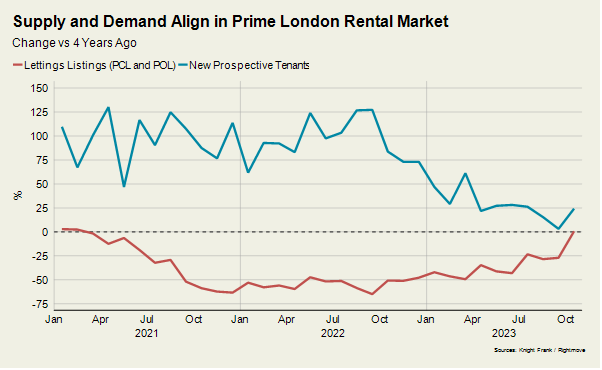London rental value growth in single digits as supply and demand align
October 2023 PCL lettings index: 218.8
October 2023 POL lettings index: 219.4
2 minutes to read
Normality appeared on the horizon in the prime London rental market in October.
High demand and low supply have pushed up rental values at unprecedented rates over the last two years, but the financial pain for tenants is reducing as the market re-balances.
Average rents in prime central (9.6%) and outer London (8.3%) both grew by less than 10% in the year to October, the first time the annual rate has been in single digits since September 2021. Furthermore, there was no monthly change to average rents in either market, the first time they have been flat since April 2021.
Overall, the supply of lettings property in PCL and POL was 0.6% higher than in 2019, as the below chart shows. Meanwhile, the number of new prospective tenants has calmed down in recent months.
Supply has been driven lower in recent years as landlords have faced a proliferation of red tape and higher taxes. Meanwhile, demand has been underpinned by a sharp rise in mortgage rates that has forced more prospective buyers to become tenants.

As the situation re-balances, supply has increased to a greater extent in higher-value markets where owners, who typically have more financial flexibility, have opted to let out their property given the weakness in the sales market, a trend we explored in more detail last month.
As a result of this building supply in higher-value markets, average rental values above £2,000 per week only rose 2.9% in the year to October in POL, while there was a rise of 11.6% between £500 and £750 per week. In prime central London, there was an increase of 7.3% above £2,000 per week and 9.1% between £750 and £1,000 per week.
Despite the slowdown, average rents in PCL are 32% higher than they were before the pandemic while the equivalent increase is 28% in POL.
Higher rents and a weak sales market also mean yields are rising. The average gross yield in PCL in October was 4.15%, which compares to 3.42% before the pandemic.
While this will attract some landlords into the sector, rising mortgage costs, tax and red tape are likely to keep downwards pressure on supply.
The latest piece of legislation that may deter landlords is the Renters Reform Bill, which is currently going through Parliament. However, discussions feel somewhat hypothetical given the general election on the horizon.
For example, there have been arguments over the abolition of Section 21 no-fault evictions and whether this will need to wait until the courts are ready to cope with the workload. It has become a politically-charged debate, but an incoming Labour government could abolish no-fault evictions whether the courts are ready or not.
In the meantime, rents are only likely to keep going in one direction.
Subscribe for more
Get exclusive market analysis, news and data from our research team, straight to your inbox.
Subscribe here